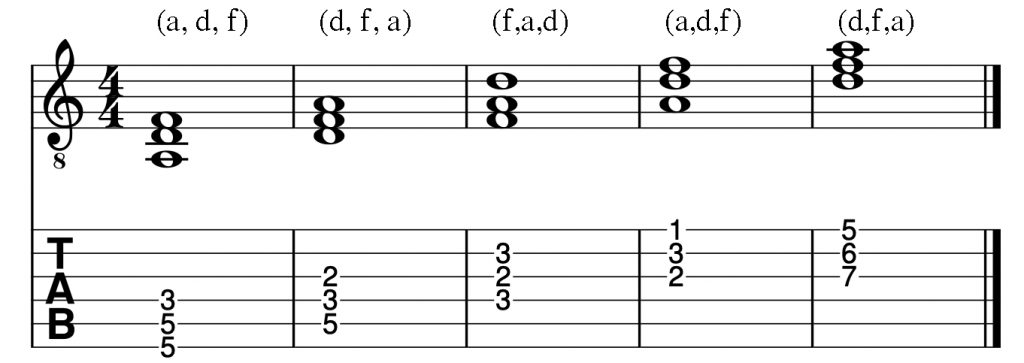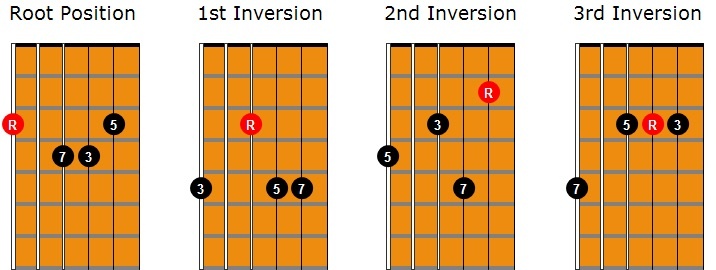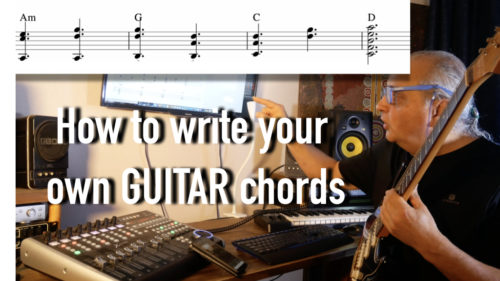Explore guitar accompaniment insights from my 38-year journey as a composer and artist. Addressing frustration…

Exploring Guitar Chords for Creativity
Introduction to Expanding Guitar Chords: Unleashing Melodic Potential
The post aims to transform how guitarists approach chords by emphasizing their melodic potential and encouraging creative exploration.
Intended Audience: Guitarists seeking to enhance chord-playing skills, delve into melodic chord usage, and deepen their musical understanding.
What the Reader Will Learn: Readers will learn to:
- View chords beyond strumming, exploring their melodic roles.
- Prioritize melody before chords to grasp chord changes effectively.
- Master techniques like pivoting for rich chordal melodies.
- Understand the importance of 7th chords for harmonic depth.
- Recognize the impact of chord shapes on musical context.
- Appreciate the harmony between chords and scales for a comprehensive musical grasp.
What are chords for?
Chords are groups of notes played simultaneously to define areas of harmonic tension. We commonly use chords to play rhythm on the guitar. Unfortunately, we can easily fall into the trap of considering a chord as a shape that we must strum, and not as a group of notes that can be played in any order we wish, with the sole purpose of defining the desired harmonic tension of the passage. Chords are generally used to define rhythm, but if needed, chords can help us define the melody of a song.
Guitarists' Strumming Trap: Melody Matters
Most instruments do not play chords as guitarists do. On the guitar, we fall into the habit of playing all the notes of the chord at once – we strum – because it is hard to play a chord as a piano player, a bass player, or as Bach would.
It is easy to strum a chord, but this can produce little musicality and generally creates a wall of sound that can obscure the beauty of the melody and the accompaniment.
It is extremely unfortunate for YouTube to be flooded with guitarists who have created a school of thinking that makes us believe that the role of the guitar is only about playing chords. When we play a song, all we have to do is play a group of chords without worrying about the melody.
This simplistic approach will produce great frustration in your learning and destroy any possibility of creativity in your performance.
Understanding Chords Effectively
Students must learn to understand why and when to use a chord. Please avoid the process of learning a song where you start playing the chords directly. First, learn the melody of the song, sing it, and then learn the chords to accompany your singing.
You must sing and be able to produce the melody because only then will you understand what it means to play a chord and when to change.
You must learn to hear, sing a melody, and also be able to play it on the guitar in the simplest manner. Once you have this sorted out, and of course, played it all in tempo, you will be ready to understand what it means to accompany a melody and how to do so with chords.
At my Creative Guitar School, I apply these concepts to all guitar lessons, courses, and levels.
Enhancing Chord Learning Through Context
I suggest learning basic chords in one position to start, but in a manner that makes more sense. That is, in a musical context with a starting point, ending, tempo, and melody.
Please follow these links for a video transcript of my beginners’ course. You can read about how to learn the C and Am chords, the Em and G chords, and the Dm and F chords.
In all my guitar courses, I teach how to play chords in a song context, always giving melodic values to all chordal notes. As a consequence, they sound better, feel more enjoyable, and make much more musical sense.
This is especially relevant in the recording process of any song to deliver a more professional music production to your listener.
Chords for Melodic Expression
I believe that guitarists deserve more than just the option of strumming chords. We should enjoy the art of creating melodies with chords, similar to how a piano player does. However, due to the way the guitar is constructed, this can be a daunting process to master, and that is why we often revert to standard shapes, ultimately sounding like everyone else.
Melodic Triad Techniques
I have created an online course called “Pivoting Techniques,” where you learn to create melodies with triads in closed positions. This involves adding tension to the top voice, introducing passing tones to inner voices, and incorporating 7ths into triads in root position.
This concept takes approximately 50 hours of study to grasp in one guitar position. However, the musical outcome is highly rewarding. You’ll soon be capable of creating melodies on the fly, generating rich accompaniments, and experiencing tremendous enjoyment in the process.
Be aware: Most guitarists don’t realize the significance of accompaniment and the need for rich musical clarity to reinforce the lead line. Defining the groove with chords and establishing a flow of tension and release are essential to sustain the melody and vocal line throughout a song.
This cannot be achieved with standard shapes or bar chords, which tend to sound muddled. Instead, you should use shapes that naturally reflect harmonic order, such as chord shapes that mimic the harmonics of the harmonic series. Triads in closed positions achieve this effectively.

Exploring 7th Chord Harmonies
In certain music styles, you’ll need to play with increased tension. 7th chords introduce another level of harmonic flow. When playing triads, adding 7ths as a passing tone can temporarily alter the chord’s tension.
However, in 7th chords, the 7th remains, and more tension is added by including upper tensions like 9th, 11th, and 13th.
To play seventh chords, you must use shapes derived from balanced closed positions. Playing 7th chords in closed positions on the guitar is challenging, so altering them by expanding and lowering internal notes by an octave is necessary.
These shapes, known as drop 2, drop 3, and drop 2 and 4, produce balanced sounds. Mastering them is crucial to grasp the beauty of 7th harmony and understand balanced and unbalanced sounds.
Whether playing lead or rhythm on the guitar, sounding good independently is essential. Illogical musical phrases won’t make sense. Your chords should stand alone and sound complete. Learning drop 2 – 4, drop 3, or drop 2 shapes is vital to create bass lines and melodic phrases when needing the density of 7th chords in your playing.

Summary
Exploring Melodic Potential with Guitar Chords
This comprehensive exploration introduces guitarists to a fresh perspective on chords, emphasizing their untapped melodic capabilities and encouraging innovative exploration. Tailored to guitarists aspiring to elevate their chord-playing prowess, delve into melodic chord applications, and enhance their musical comprehension.
Key Learning Points:
- Chords Beyond Strumming: Chords extend beyond strumming, evolving into melodic tools.
- Prioritizing Melody: Emphasizing melody before chords for effective chord transitions.
- Mastering Pivoting Techniques: Proficiency in techniques like pivoting for intricate chordal melodies.
- 7th Chords for Depth: Recognizing the importance of 7th chords for enriching harmonic depth.
- Impact of Chord Shapes: Understanding how chord shapes influence musical context.
- Harmony between Chords and Scales: Grasping the interplay between chords and scales for a holistic musical grasp.
Target Audience: Guitarists eager to refine chord-playing skills, explore innovative melodic chord approaches, and deepen their musical understanding.
Conclusion: This exploration delves into the synergy of chords and melodies, challenging conventional chord-centric approaches. By expanding chord comprehension, guitarists unlock a world of melodic possibilities, fostering creativity and enhancing their musical journeys.

